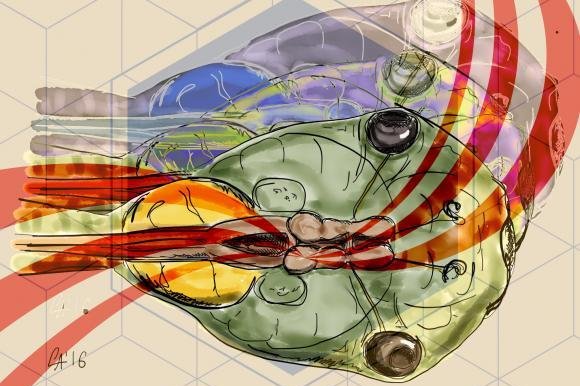New research reveals how the tadpole brain learns to process simultaneous sensory signals. Photo by Carlos Aizenman/Brown University
PROVIDENCE, R.I., June 3 (UPI) -- For most people, the world is experienced as a symphony of sensory inputs -- or, sometimes, a cacophony. We don't process each single sensory input, one at a time. Or at least it doesn't feel that way.
But new science suggests we shouldn't take this sense of simultaneity for granted.
The ability to perceive multiple senses at the same time -- to sense their source and simultaneous arrival -- is an ability that must be developed. It is this developed ability that allows humans to effectively see, hear and process a movie or interact with a person who is talking, gesturing and making facial expressions.
A better understanding of how this ability originates and develops in the brain could help scientists address its malfunction. Some researchers believe an inability to process multiple sensory inputs could explain language learning difficulties in autism patients.
"People have tried to distill how the brain detects this temporal coincidence," Carlos Aizenman, a professor of neuroscience at Brown University, said in a news release. "We created a preparation where we could study how the different inputs are combined in a single cell and what types of brain circuits are involved."
To better understand temporal coincidence, researchers looked at tadpole brains. Sensory inputs are processed by the optic tectum in the tadpole brains, an area analogous to the superior colliculus in mammals and humans.
Researchers tracked neuron activity in the optic tectum both earlier and later in the tadpoles' development. Activity was measured in response to sound and vibration inputs that register temporally closer or farther apart by a fraction of a second.
Early in their development, the tadpoles' optic tectum neurons would become excited and remain excited by two sensory inputs separated by a relatively significant amount of time. The same inputs, separated by the same amount of time, were processed differently by more mature tadpoles. Mature tadpoles suppressed their initial excitement, but showed similar excitement when the two inputs registered nearly simultaneously.
The findings, detailed in the journal eLife, suggest the developing brain becomes more sophisticated in its processing of sensory signals. Over time, inhibitory neurons balance out excitatory neurons.
"The brain normally starts out poorly wired," Zizenman explained. "Activity in the brain sculpts the response of the brain to have a much more refined and fine-tuned function."
"The balance of excitation and inhibition in the brain is important for creating this type of temporal window," he continued. "If you disrupt it, you get abnormal multisensory processing."
Researchers plan to do further work to see how and where in the development process this balancing act can be derailed -- and to see what sort of physiological consequences there are for tadpoles as they interact with the world.















